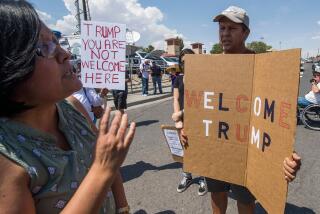The good generation gap
It will be a while before the pollsters tease the full story of Tuesday’s quasi-national primary out of their exit surveys. It’s already possible, however, to discern a cause for optimism in the reemergence of what we used to call “the generation gap.”
At first blush, that’s a counter- intuitive reaction, but consider this: In recent years, a good bit of our system’s cripplingly bitter partisanship could be attributed to the drift by growing numbers of Democrats into identity politics -- aligning by race or ethnicity -- and by the movement of more Republicans toward confessional politics -- that is, into the religious right.
The functional problem with both identity and confessional politics is that they make no room for compromise. When your position on any given question grows mainly out of your ethnicity or your spiritual convictions, there’s no way to meet the other guy halfway without ceasing, in some essential way, to be yourself. In other words, compromise is suicide.
When people divide along generational lines, however, it’s a natural outgrowth of time and experience -- things that yield malleable conclusions about which people may differ, reason and negotiate, and that’s what healthy politics are all about. Historian Arthur M. Schlesinger Jr. used to say that the genius of the American people was in their preference for solutions -- what he called “the politics of remedy” -- over ideological purity.
It’s a hopeful trend, therefore, when polls show significant numbers of young Latinos eager to step across traditional ethnic dividing lines to vote for Sen. Barack Obama. Similarly, when measurable numbers of young evangelical Christians put aside their elders’ traditional reservations about Mormonism and vote for Mitt Romney because they respect his economic credentials or find him the most authentically conservative candidate, you’re working from reason and not revelation -- and that’s a good thing.
So far, Obama appears to be the principal beneficiary of this trend, not simply because “change” is a mantra that resonates with the young but because he personifies and articulates the post-racial America in which most of our young people now live (especially the ones in multiethnic urban centers such as Los Angeles).
Anyone with children in their 20s or younger knows that they deal with race and ethnicity in ways different from their elders. Skin color is no longer a physical marker for most of them. By and large, our sons and daughters describe their friends as tall or short, funny or serious, as good students or poor athletes, but seldom -- as earlier generations would have done -- as a “black guy” or a “white girl.” They take the sound of Spanish and the sight of Korean shop signs for granted.
Their America is one in which the last two secretaries of State have been African American and the first Latino attorney general came and went without much notice -- all, by the way, named by a Republican president, something no one in his party even bothers to note to his credit.
Here in Los Angeles, the Obama phenomenon seems less striking than elsewhere because Antonio Villaraigosa swept into the mayor’s office with a similarly post-racial, post-ethnic brand of politics. That’s what enabled him to peel a significant number of younger African American voters away from the incumbent mayor, James Hahn, whose family had deep roots in the city’s black community.
One of the interesting things to watch from here on out will be the way the post-racial rhetoric of political leaders like Obama and Villaraigosa adapts itself to the substantial number of issues that still are tinged by race. Over the last week, for example, The Times’ Sam Quinones has reported on a murderous outbreak of violence between rival black and Latino gangs in the small San Gabriel Valley city of Monrovia, and staff writer Jill Leovy has written of how the roughly 1,000 L.A. County homicides she covered for the paper’s website last year overwhelmingly involved young African Americans and Latinos.
What the post-racial perspective of this new generation gap may offer us is a chance to see that many of the problems we continue to regard as most intractable are rooted in issues of class rather than race.
Certainly that’s true in Los Angeles, where the vast majority of homicides involve brown-on-brown or black-on-black violence rather than racial antagonisms. In Monrovia, it appears that a generally well-integrated little city simply left a mainly minority neighborhood behind in an otherwise well-managed redevelopment program. In both cases, there’s racial isolation, but it’s the legacy of a previous generation’s residential segregation rather than a consequence of ongoing prejudice.
At the short end of the economic stick, there’s a reason nobody gets along with anybody. We don’t often find ourselves decrying gang violence on the mean streets of San Marino or Hancock Park.
More to Read
Sign up for Essential California
The most important California stories and recommendations in your inbox every morning.
You may occasionally receive promotional content from the Los Angeles Times.










